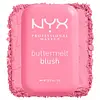What's inside
What's inside
 Key Ingredients
Key Ingredients

 Benefits
Benefits

 Concerns
Concerns

 Ingredients Side-by-side
Ingredients Side-by-side

Mica
Cosmetic ColorantCI 77891
Cosmetic ColorantTalc
AbrasiveSilica
AbrasiveLauroyl Lysine
Skin ConditioningTrimethylsiloxyphenyl Dimethicone
Ethylhexyl Palmitate
EmollientZinc Stearate
Cosmetic ColorantCI 15850
Cosmetic ColorantCI 45410
Cosmetic ColorantOctyldodecanol
EmollientMangifera Indica Seed Butter
Skin ConditioningHelianthus Annuus Seed Oil
EmollientPrunus Amygdalus Dulcis Oil
Skin ConditioningButyrospermum Parkii Butter
Skin ConditioningAroma
Caprylyl Glycol
EmollientIsostearyl Isostearate
EmollientOctyldodecyl Stearoyl Stearate
EmollientTocopherol
AntioxidantPhenoxyethanol
PreservativeLinalool
PerfumingLimonene
PerfumingMica, CI 77891, Talc, Silica, Lauroyl Lysine, Trimethylsiloxyphenyl Dimethicone, Ethylhexyl Palmitate, Zinc Stearate, CI 15850, CI 45410, Octyldodecanol, Mangifera Indica Seed Butter, Helianthus Annuus Seed Oil, Prunus Amygdalus Dulcis Oil, Butyrospermum Parkii Butter, Aroma, Caprylyl Glycol, Isostearyl Isostearate, Octyldodecyl Stearoyl Stearate, Tocopherol, Phenoxyethanol, Linalool, Limonene
Talc
AbrasiveMagnesium Myristate
Silica
AbrasiveCalcium Aluminum Borosilicate
Dimethicone
EmollientCaprylic/Capric Triglyceride
MaskingLauroyl Lysine
Skin ConditioningSimmondsia Chinensis Seed Oil
EmollientSynthetic Fluorphlogopite
Diethylhexyl Syringylidenemalonate
Skin ProtectingTrimethylsiloxysilicate
EmollientPhenoxyethanol
PreservativeChlorphenesin
AntimicrobialOctyldodecanol
EmollientButylene/Ethylene Copolymer
Talc, Magnesium Myristate, Silica, Calcium Aluminum Borosilicate, Dimethicone, Caprylic/Capric Triglyceride, Lauroyl Lysine, Simmondsia Chinensis Seed Oil, Synthetic Fluorphlogopite, Diethylhexyl Syringylidenemalonate, Trimethylsiloxysilicate, Phenoxyethanol, Chlorphenesin, Octyldodecanol, Butylene/Ethylene Copolymer
 Reviews
Reviews

Ingredients Explained
These ingredients are found in both products.
Ingredients higher up in an ingredient list are typically present in a larger amount.
This ingredient comes from a fatty acid (lauric acid) and amino acid (lysine). It is used to add a silky feel to cosmetics.
According to a manufacturer, its fatty acid base leaves a silky feeling on the skin. It also has emollient properties because of this. Emollients help soften skin by preventing water from evaporating.
Lauroyl lysine is barely soluble in water.
Learn more about Lauroyl LysineOctyldodecanol is a fatty alcohol. It is primarily used to enhance the texture of products.
As an emulsifier, Octyldodecanol helps prevent the oils and waters from separating. It also prevents ingredients from creating foam when shaken.
Octyldodecanol is created by reducing fatty acid to an alcohol.
Due to its high molecular weight, it does not get absorbed into the skin.
Learn more about OctyldodecanolPhenoxyethanol is a preservative that has germicide, antimicrobial, and aromatic properties. Studies show that phenoxyethanol can prevent microbial growth. By itself, it has a scent that is similar to that of a rose.
It's often used in formulations along with Caprylyl Glycol to preserve the shelf life of products.
Silica, also known as silicon dioxide, is a naturally occurring mineral. It is used as a fine, spherical, and porous powder in cosmetics.
Though it has exfoliant properties, the function of silica varies depending on the product.
The unique structure of silica enhances the spreadability and adds smoothness, making it a great texture enhancer.
It is also used as an active carrier, emulsifier, and mattifier due to its ability to absorb excess oil.
In some products, tiny microneedles called spicules are made from silica or hydrolyzed sponge. When you rub them in, they lightly polish away dead skin layers and enhance the penetration of active ingredients.
Learn more about SilicaTalc is a clay mineral. It helps absorb moisture and improve the texture of products. Like other types of clay, Talc can have a slight exfoliating effect on skin. Talc can be added to increase the volume of products.
Some Baby powders are made by combining talc with corn starch. The word "talc" comes from Latin and originates from Arabic. Talc is a mineral commonly found throughout the world.
If you have any concerns about using talc, we recommend checking out the FDA's official page.
Learn more about Talc